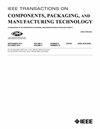Gate Oxide and Package Reliability of TO-263 SiC MOSFETs
IF 3
3区 工程技术
Q2 ENGINEERING, ELECTRICAL & ELECTRONIC
IEEE Transactions on Components, Packaging and Manufacturing Technology
Pub Date : 2025-07-15
DOI:10.1109/TCPMT.2025.3589429
引用次数: 0
Abstract
This article presents a comprehensive reliability analysis of TO-263 silicon carbide MOSFETs (SiC MOSFETs) from four different vendors, focusing on gate oxide and package degradation. A range of accelerated aging tests (AATs), including positive high-temperature gate bias (PHTGB), negative high-temperature gate bias (NHTGB), high-temperature reverse bias (HTRB), and dc power cycling (DCPC), are conducted to investigate both gate oxide and package reliability. The findings from HTGB and HTRB tests emphasize that even a 10 nm reduction in gate oxide thickness can significantly impact gate oxide reliability compared to similar designs. Furthermore, the results from NHTGB show that the devices are more prone to failure compared to PHTGB, disproving the idea that the device lifetime is longer in the off-state compared to the on-state. The conclusions are drawn from measurements using focused ion beam (FIB) and transmission electron microscopy (TEM), which provide detailed cross-sectional images of the devices. Additionally, the reliability of the TO-263 package is assessed, highlighting solder fatigue failure between the device and the printed circuit board (PCB) as a significant issue. This failure mechanism can lead to the detachment of the device from the PCB, resulting in a loss of connection. The study underscores the importance of optimizing gate oxide thickness and addressing thermal–mechanical stresses to enhance the overall reliability of SiC MOSFETs with TO-263 packages in high-power applications.TO-263 SiC mosfet的栅极氧化物和封装可靠性
本文介绍了来自四个不同供应商的TO-263碳化硅mosfet (SiC mosfet)的全面可靠性分析,重点是栅极氧化物和封装退化。通过一系列加速老化试验(AATs),包括正高温栅极偏置(PHTGB)、负高温栅极偏置(NHTGB)、高温反向偏置(HTRB)和直流功率循环(DCPC),研究栅极氧化和封装可靠性。HTGB和HTRB测试的结果强调,与类似设计相比,即使栅氧化层厚度减少10 nm,也会显著影响栅氧化层的可靠性。此外,NHTGB的结果表明,与PHTGB相比,设备更容易发生故障,这反驳了设备在关闭状态下的寿命比在打开状态下更长的观点。这些结论是通过聚焦离子束(FIB)和透射电子显微镜(TEM)的测量得出的,它们提供了器件的详细横截面图像。此外,对TO-263封装的可靠性进行了评估,突出了器件与印刷电路板(PCB)之间的焊料疲劳失效是一个重要问题。这种失效机制可能导致器件从PCB上脱离,从而导致连接丢失。该研究强调了优化栅极氧化物厚度和解决热机械应力的重要性,以提高具有to -263封装的SiC mosfet在高功率应用中的整体可靠性。
本文章由计算机程序翻译,如有差异,请以英文原文为准。
求助全文
约1分钟内获得全文
求助全文
来源期刊

IEEE Transactions on Components, Packaging and Manufacturing Technology
ENGINEERING, MANUFACTURING-ENGINEERING, ELECTRICAL & ELECTRONIC
CiteScore
4.70
自引率
13.60%
发文量
203
审稿时长
3 months
期刊介绍:
IEEE Transactions on Components, Packaging, and Manufacturing Technology publishes research and application articles on modeling, design, building blocks, technical infrastructure, and analysis underpinning electronic, photonic and MEMS packaging, in addition to new developments in passive components, electrical contacts and connectors, thermal management, and device reliability; as well as the manufacture of electronics parts and assemblies, with broad coverage of design, factory modeling, assembly methods, quality, product robustness, and design-for-environment.
 求助内容:
求助内容: 应助结果提醒方式:
应助结果提醒方式:


